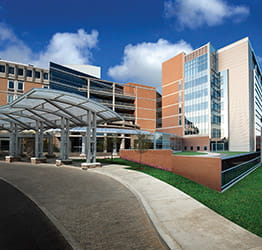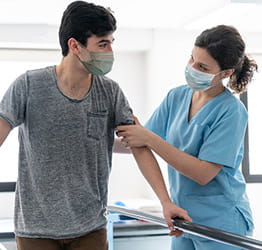What Your Pathology Report Includes
Your pathology report will include personal details, such as your name, date of birth, and address. It will also specify the location from which your tissue sample was taken. Additionally, the report will explain how your breast abnormality was detected, for example, by mammogram.
Next, the report will discuss the diagnosis that the doctors were expecting before your tissue sample was tested. Your report will also describe the size, weight, and color of the pieces of tissue that were removed.
The following two parts of the report discuss what was found in each test of your tissue.
These parts are the:
- Microscopic description.
- Special tests or markers.
The final part of your pathology report provides a short description of all the important findings in the tissue that was examined. This is the summary or final diagnosis.
Microscopic description results
Within this section, you will find answers to specific questions about your breast abnormality, including:
- Is it cancer?
- If it is cancer, is it invasive?
- How different are the cancer cells from normal cells?
- How fast are the cancer cells growing?
- How big is the cancer?
- Has the whole cancer been removed?
- Are there cancer cells in your lymph channels or blood vessels?
- Are there cancer cells in your lymph nodes? If so, how many lymph nodes are involved?
To answer these questions, the pathologist will study your cancer cells under the microscope. The pathologist will also examine the relationship between your cancer cells and the surrounding normal tissue.
Is it cancer?
A breast abnormality isn’t always cancer. Sometimes, it is simply a collection of normal cells. In other cases, it is made up of cells that fall somewhere between normal and cancerous. These are called atypical cells.
To determine if the abnormality is cancer, the pathologist will look at how the cells are growing and spreading. Cancer cells grow in an uncontrolled way. They may grow into the nearby tissue or travel to other areas of the body.
Is it invasive?
If the cancer stays within the milk ducts or milk lobules in the breast and does not affect surrounding tissue, then it is noninvasive. These cancers may also be called “in situ” or precancers.
If the cancer has grown into surrounding tissue or has spread to other parts of the body through the blood or lymph system, then it is invasive. Cancer cells that spread to other parts of the body are called metastatic breast cancer.
During a biopsy, tissue samples are taken from the abnormality and the surrounding tissue. The pathologist will study these samples for cancer cells to determine if your cancer is invasive or noninvasive.
Here are some of the ways that your cancer cells may be described in your pathology report:
- Ductal carcinoma in situ (DCIS) — DCIS is an early-stage breast cancer that develops in the lining of the milk ducts and has not spread to other parts of your body.
- Lobular carcinoma in situ (LCIS) — LCIS starts in the glands that produce milk, called the lobules, and has not spread to other parts of your body. Although not technically considered cancer, LCIS increases your risk of developing breast cancer in the future.
- Invasive ductal carcinoma (IDC) — The most common type of breast cancer, invasive ductal carcinoma accounts for 70% to 80% of breast cancer cases in women and 90% in men. This type of breast cancer starts in the lining of your milk ducts and may be preceded by ductal carcinoma in situ.
- Invasive lobular carcinoma (ILC) — The second most common type of breast cancer, invasive lobular carcinoma accounts for 10% of breast cancer cases in women. It begins in the glands that produce milk.
How different are the cancer cells from normal cells?
Cancer cells are given a “grade” based on how different they look when compared to normal breast cells.
These grades are:
- Grade 1 (low-grade or well-differentiated) — Look a little different from normal cells and are usually slow-growing.
- Grade 2 (intermediate/moderate grade or moderately different) — Don’t look like normal cells, and are faster-growing than normal.
- Grade 3 (high-grade or poorly differentiated) — Look very different from normal cells, and are fast-growing.
How fast are the cancer cells growing?
Pathologists will conduct tests to determine the number of cells in your tumor that are growing. They will also look at the rate of cell growth, which will help them determine if your cancer is aggressive.
The two key tests are:
- Ki-67 test — The first test looks for a protein called Ki-67. This protein increases as cells prepare to divide into new cells. The more cells that are positive for Ki-67, the faster the cells are growing and dividing. A result of less than 10% is considered low, 10% to 20% is considered intermediate/borderline, and more than 20% is high.
- S-phase fraction test — A second test called S-phase fraction will determine what percentage of cells in the tissue are in the process of copying their DNA. S-phase is short for “synthesis phase.” This process occurs just before a cell divides. A result under 6% is considered low, 6% to 10% is considered intermediate/borderline, and more than 10% is high.
How big is the cancer?
Size is one of the characteristics used to determine the stage and treatment of your cancer. Doctors measure cancers in centimeters.
Has the whole cancer been removed?
When cancer is removed, the surgeon also takes a portion of the surrounding tissue. The surrounding tissue is referred to as the margin of resection. A pathologist will examine this margin to make sure that it is free of cancer cells. Checking the margin will determine if the whole cancer has been removed.
Your pathology report will describe the margin as one of the following:
- Negative (clean) — No cancer cells are found in the margin, and no additional surgery is needed.
- Positive — Cancer cells were found at the edge of the margin, and additional surgery is needed to remove the remaining cells.
- Close — Cancer cells were found close to the edge of the margin, and additional surgery may be needed.
Are there cancer cells in your lymph channels or blood vessels?
Fluid and blood from your breast tissue are drained from the breast through blood vessels and lymph channels. If cancer cells are found in these vessels or channels, there is an increased risk that your cancer will return. Your pathology report will say “present” if cancer cells are found. If there are no cancer cells in these areas, your report will say “absent.”
Are there cancer cells in your lymph nodes?
There are several lymph nodes located around the perimeter of your breast. The lymph nodes are small structures that filter harmful waste out of lymph fluid before it enters the bloodstream. The lymph nodes contain immune cells that can help fight infection and destroy germs.
When cancer cells are found in the lymph nodes, there is an increased risk that the cancer will spread. If cancer cells are found in your lymph nodes, your report will say “positive.” If there are no cancer cells in your lymph nodes, then your report will say “negative.”
How many lymph nodes are involved?
Your treatment will vary depending on how many lymph nodes contain cancer cells and how much cancer is in each node.
The following terms are used when referring to the amount of cancer in each node:
- Microscopic — Only a few cancer cells were found in the node, and a microscope was needed to see the cells.
- Gross — Many cancer cells were found, and they can be seen or felt without a microscope.
- Extracapsular extension — Cancer was found outside the wall of your lymph node.
Special tests or markers
This portion of your pathology report focuses on the proteins and genes contained within the cancer. It also looks more closely at the rate at which cancer cells are growing.
Within this section, the following questions will be answered:
- Do the cancer cells have hormone receptors?
- Does the cancer have genes that affect how the cancer might be treated?
Do the cancer cells have hormone receptors?
Hormone receptors are located within cells. They “listen” for signals from hormones that tell the cell to grow. Some receptors respond to the hormone estrogen. Others respond to progesterone.
When a cancer contains a hormone receptor that responds to estrogen, it is called ER-positive. When a cancer contains a hormone that responds to progesterone, it is PR-positive. A breast cancer that is ER-positive, PR-positive, or both is typically treated with endocrine therapy, also known as hormone therapy.
Within this portion of the pathology report, you will see your results listed in terms of the number of cells that have receptors out of 100 cells tested. This number will be given as a percentage.
Results also may show:
- An Allred score between 0 and 8 — This system measures both the percentage of positive cells and how well the receptors show up. This is called intensity. The higher the score, the more receptors there were and the easier they were to see.
- The word positive or negative — Even if your report says “negative,” you may respond to endocrine therapy if you have a low number of hormone receptors.
Does the cancer have genes that affect how the cancer might be treated?
Genes make the proteins that cells need to work properly. This is called a genetic recipe. Some genes can influence the behavior of breast cancer, including how it responds to treatment.
Pathologists will test cancer cells to see which genes and proteins are normal or abnormal. If the genetic recipe contains a mistake, it is called a “genetic mutation” or “genetic abnormality.” The report will say “gene amplification” if the genetic recipe repeats the same instruction multiple times. This causes the gene to make too many copies of itself.
If the genetic recipe calls for too much protein to be made, it is referred to as an “overexpression” of that protein.
HER2 protein
One protein that pathologists look for specifically is called HER2.
The HER2 protein is a receptor that controls how a breast cell grows, divides and repairs itself. It is made by the HER2 gene and is a receptor on breast cells.
Sometimes, the HER2 gene becomes abnormal and makes too many copies of itself. This “amplification” of the HER2 gene occurs in about 25 percent of breast cancers. Amplified HER2 genes produce too much HER2 protein. This causes the breast cells to grow and divide uncontrollably, which can lead to breast cancer.
A pathology report will describe the cancer as HER2-positive when it has either amplified HER2 genes or overexpressed HER2 protein. These HER2-positive breast cancers grow faster and are more likely to come back. Fortunately, they respond to targeted treatments that work against HER2-positive cells.
There are four tests for HER2, including:
- Immunohistochemistry (IHC) test — Shows if there is too much HER2-receptor protein in the cancer cells. Results can be 0 (negative), 1+ (also negative), 2+ (borderline), or 3+ (positive).
- Fluorescence in situ hybridization (FISH) test — Shows if there are too many copies of the HER2 gene in cancer cells. Results can be positive (extra HER2 gene copies) or negative (normal number of HER2 gene copies).
- Subtraction probe technology chromogenic in situ hybridization (SPoT-Light HER2 CISH) test — Shows whether there are too many copies of the HER2 gene in the cancer cells. Results can be positive (extra copies) or negative (normal number of copies).
- Inform HER2 dual in situ hybridization (ISH) test — Shows whether there are too many copies of the HER2 gene in the cancer cells. Results can be positive (extra copies) or negative (normal number of copies).
It is important to find out which test for HER2 you had. Targeted therapy for HER2-positive breast cancers is only effective when the results are:
- IHC 3+
- FISH positive
- SPoT-Light HER2 CISH positive
- Inform HER2 Dual ISH positive
An IHC +2 result is called borderline. If you get this result, you should ask to have the tissue tested with the FISH test.
Summary or final diagnosis
Within this section of the pathology report you will find the “bottom line” results. If cancer has been diagnosed, this section will include the following:
- The type of cancer.
- The tumor grade.
- Lymph node status.
- Margin status.
- Stage of your cancer.
- Results of tests for hormone receptors and HER2 or other genes.
These findings will help you and your UPMC breast care team develop a treatment plan that offers the best possible outcome for your cancer.
Glossary
The following list of terms from BreastCancer.org will help you better understand some of the language used within your pathology report.
- Abnormal cells — Cells that do not look or act like the healthy cells of the body.
- Aggressive cancer cells — Cells that are fast-growing and have a tendency to spread beyond the area where they started.
- Atypical ductal hyperplasia — Abnormal cells that have accumulated in a breast duct. The cells have increased in number and fill almost the entire duct. The cells can continue to change until they develop into DCIS. Atypical ductal hyperplasia can increase the risk of a future breast cancer.
- Atypical lobular hyperplasia — Abnormal cells that have accumulated in a breast lobule. The cells have increased in number and fill almost the entire lobule. It’s possible for the cells to keep changing until they become LCIS. Atypical lobular hyperplasia can increase the risk of future breast cancer.
- Axillary lymph nodes — Lymph nodes under your arms.
- Basal-like breast cancer — Basal-like is one of the four main molecular subtypes of breast cancer. Basal-like breast cancer is hormone receptor-negative and HER2-negative. Also called triple-negative breast cancer.
- Benign — Not cancerous or precancerous.
- Biopsy — An operation to remove tissue to check whether it’s cancerous or not.
- BRCA1 — An abnormal gene, known as breast cancer gene 1, associated with a higher risk of developing breast cancer.
- BRCA2 — An abnormal gene, known as breast cancer gene 2, associated with a higher risk of developing breast cancer.
- Clean margins — Removed breast tissue around the tumor in which the outer edge is free of cancer cells. Also called “negative margins.”
- Close margins — Removed breast tissue around the tumor, where cancer cells come near the outer edge.
- Colloid (mucinous) carcinoma of the breast — A rare type of invasive breast cancer that contains small pools of mucous material.
- Comedo DCIS — A type of non-invasive cancer that tends to grow quickly. Comedo refers to areas of dead cancer cells that build up inside the tumor — a sign that the cancer cells are growing so rapidly that some of them are not receiving enough nourishment.
- Comedonecrosis — Clumps of dead cancer cells, often seen in high-grade DCIS. The cells are so crowded that some of them do not get enough nourishment and die.
- Cribriform carcinoma of the breast — A less common type of invasive breast cancer that invades the connective tissues of the breast and features holes between the cancer cells (like the holes in Swiss cheese).
- Cribriform DCIS — A type of noninvasive breast cancer that usually grows slowly. Cribriform DCIS features gaps between cancer cells in the affected ducts (like the pattern of holes in Swiss cheese).
- Ductal carcinoma in situ (DCIS) — An uncontrolled growth of breast cells within the milk duct without invasion into the normal surrounding breast tissue.
- EGFR gene — A gene that controls how quickly cells divide. Also called HER1.
- EGFR-negative — A breast cancer with a normal number of the EGFR gene.
- EGRF-positive — A breast cancer with too many copies of the EGFR gene.
- ER-negative — A cancer that does not have estrogen receptors.
- ER-positive — A cancer that has estrogen receptors.
- Estrogen — The major female sex hormone. Estrogen can cause some cancers to grow.
- Extracapsular extension — When cancer has spread outside the wall of a lymph node.
- Fibrocystic changes — Benign changes in the breast, such as large amounts of rubbery, firm (“fibrous”) tissue or fluid-filled cysts.
- FISH (fluorescence in situ hybridization) test — A test for multiple genes, including the HER2 gene.
- Gene — The code material for a cell to make a single protein. Proteins perform different functions for the cell including growth and repair.
- Genomic assay — A test that analyzes the activity of a group of genes.
- Grade — How different the cancer cells look from normal cells as well as how quickly the cells are growing.
- Gross lymph node involvement — A situation in which many cancer cells are found in a lymph node.
- HER2 (Human epidermal growth factor receptor 2) — A gene that helps control the growth and repair of cells.
- HER2-enriched — One of the four main molecular subtypes of breast cancer. HER2-enriched breast cancer is hormone-receptor-negative and HER2-positive.
- HER2 gene amplification — A situation that arises when a HER2 gene doesn’t work correctly and makes too many copies of itself.
- HER2-negative — A breast cancer with a normal number of HER2 genes and protein receptors.
- HER2-positive — A breast cancer with HER2 gene amplification or HER2 protein overexpression. HER2-positive breast cancers tend to grow faster and are more likely to spread and come back compared to HER2-negative breast cancers.
- HER2 protein overexpression — When the HER2 gene makes too many copies of itself, and those extra HER2 genes tell breast cells to make too many HER2 receptors.
- HER2 receptors — Proteins made by the HER2 gene that receive signals that stimulate cells to grow and multiply.
- Hormone receptors — Proteins on and in cells that respond to signals from hormones.
- Immunohistochemistry (IHC) test — A test used to measure proteins, including the HER2 protein.
- In situ — A cancer within the part of the breast where it started, such as in the ducts, without signs of spread.
- Infiltrating — A cancer that has spread beyond the place where it started. Also called “invasive.”
- Inflammatory breast cancer (IBC) — A rare and aggressive form of breast cancer that starts with reddening, swelling, and warmth of the breast, with symptoms worsening within days or hours. IBC is considered at least stage IIIB.
- Inform HER2 dual ISH test — A test used to figure out whether breast cancer cells are HER2-positive.
- Invasive — A cancer that has spread beyond the place where it started. Also called “infiltrating.”
- Invasive ductal carcinoma (IDC) — A cancer that started in the milk duct but has grown into the normal breast tissue around it.
- Invasive lobular carcinoma (ILC) — A cancer that started in the milk lobules and has grown into the normal breast tissue around it.
- Ki-67 test — A test that shows how fast cancer is growing.
- Lobular carcinoma in situ (LCIS) — Cells that are not normal but stay inside the milk-making parts of the breast (lobules). LCIS isn’t a true cancer, but a warning sign of an increased risk for developing an invasive cancer in the future in either breast.
- Local recurrence — A breast cancer that comes back in the breast area where it was originally diagnosed.
- Locoregional recurrence — A breast cancer that comes back in the lymph nodes in the armpit or collarbone area near where the cancer was originally diagnosed. Sometimes referred to as “regional” recurrence.
- Luminal A breast cancer — One of the four main molecular subtypes of breast cancer. Luminal A breast cancer is hormone receptor-positive (either estrogen- and/or progesterone-positive) and HER2-negative.
- Luminal B breast cancer — One of the four main molecular subtypes of breast cancer. Luminal B breast cancer is hormone receptor-positive (either estrogen- and/or progesterone-receptor-positive) and HER2-positive.
- Lymph channels — Vessels that drain clear, cell-cleansing fluid (“lymph”) away from tissues.
- Lymph nodes — Filters along the lymph fluid channels that can catch and trap cancer cells before they reach other parts of the body.
- Lymph system — A network of vessels and nodes that creates and drains clear, cell-cleansing fluid (“lymph”) from the body. The lymph system is an important part of the body’s immune system.
- Lymphatic invasion — When cancer cells are found in the lymph channels.
- MammaPrint — A test that analyzes 70 genes from an early-stage breast cancer tissue sample to find out whether breast cancer has a low or high risk of coming back within 10 years after diagnosis.
- Mammostrat — A test that measures the levels of five genes in early-stage, hormone-receptor-positive breast cancer cells. A risk index score is then calculated. The higher the score, the more likely the cancer is to come back (recur).
- Margin —The layer of healthy breast tissue around the cancer that was removed during surgery.
- Medullary carcinoma of the breast — A rare type of invasive cancer that usually presents with a soft, fleshy tumor that resembles a part of the brain called the medulla. Medullary carcinoma of the breast is usually hormone receptor-negative and HER2-negative.
- Menopause — The time when a woman completely stops getting her period (menstruating).
- Metastatic — Breast cancer that has spread to other parts of the body, such as the bones or brain.
- Microscopic invasion — A situation in which cancer cells have just started to invade the tissue outside the lining of a duct or lobule.
- Microscopic lymph node involvement — When only a small number of cancer cells are found in a lymph node.
- Milk ducts — Tiny tubes in the breast that carry milk from the lobules to the nipple.
- Milk lobules — Milk-making glands in the breast.
- Moderately differentiated — Cancer cells that don’t look like normal cells. They grow a little faster than normal. Also called “grade 2.”
- Mucinous (colloid) carcinoma of the breast — A rare type of invasive cancer that contains small pools of mucous material.
- Negative margins — Removed breast tissue around the tumor in which the outer edge is free of cancer cells. Also called “clean margins.”
- Noninvasive — A cancer that stays inside the part of the breast where it started.
- Oncotype DX — A test that provides information on how likely the breast cancer is to return and whether you are likely to benefit from chemotherapy. Oncotype DX can also determine whether someone with DCIS can benefit from radiation therapy.
- Papillary carcinoma of the breast — A rare type of invasive breast cancer that is made up of small, finger-like projections.
- Papillary DCIS — A type of non-invasive breast cancer that does not spread and tends to grow slowly. Papillary DCIS features cancer cells arranged in a finger-like pattern within the ducts.
- Pathologist — A doctor who looks at tissue under a microscope to see if it’s normal or affected by disease.
- Pathology report — The written results of each test done on tissue after it has been removed from the body during biopsy, lumpectomy, or mastectomy.
- Perimenopause — The 1- to 3-year period of hormonal flux before periods stop completely.
- Poorly differentiated — Cancer cells that look very different from normal cells. They are fast-growing. Also called “grade 3.”
- Positive margins — A situation in which cancer cells come up to the outer edge of the breast tissue that was removed during surgery. This suggests that more cancer cells were left behind in the body.
- PR-negative — A cancer that does not have progesterone receptors.
- PR-positive — A cancer that has progesterone receptors.
- Precancerous — An overgrowth of abnormal cells that shows no signs of invasion. Pre-cancerous cells are a warning sign of possibly developing cancer in the future.
- Progesterone — A female sex hormone. Progesterone can cause some cancers to grow.
- Prognosis — The most likely outcome of a disease.
- Recurrence — When a cancer comes back.
- Regional recurrence — A breast cancer that comes back in the lymph nodes in the armpit or collarbone area near where the cancer was originally diagnosed. Sometimes referred to as “locoregional” recurrence.
- S-phase fraction test — A test that shows how fast a cancer is growing.
- Sclerosing adenosis — A benign breast condition in which enlarged lobules form breast lumps.
- Sentinel lymph node — The first lymph node or nodes to which cancer cells are likely to spread from a tumor.
- Solid DCIS — A type of non-invasive breast cancer, it tends to grow slowly. Solid DCIS cancer cells fill the affected breast ducts completely.
- SPoT-Light HER2 CISH test — A test used to count the number of copies of the HER2 gene.
- Staging — A system doctors use to classify breast cancer according to how advanced it is.
- Triple-negative breast cancer — Breast cancer that tests negative for estrogen receptors, progesterone receptors, and HER2. Triple-negative breast cancer tends to be more aggressive than other types of breast cancer.
- Tubular carcinoma of the breast — A rare type of invasive breast cancer that is made up of tube-shaped cells and tends to grow slowly.
- Vascular invasion — When cancer cells are found in the blood vessels.
- Well-differentiated —Cancer cells that look a little bit different from normal cells. They are usually slow-growing. Also called “grade 1.”
Why Choose UPMC for Breast Cancer Care?
When you choose UPMC for breast cancer care, you will receive:
- Comprehensive breast cancer expertise — The breast cancer experts at UPMC provide state-of-the-art care for every form of breast cancer at every stage of the disease.
- Personalized, collaborative care — Our surgical, medical, and radiation oncologists work together to plan the best course of therapy for you.
- Supportive services tailored to your needs — Our approach to breast cancer care honors your preferences by blending advanced clinical methods with supportive services for the best possible results.
By UPMC Editorial Staff. Last reviewed on 2025-09-18.
















